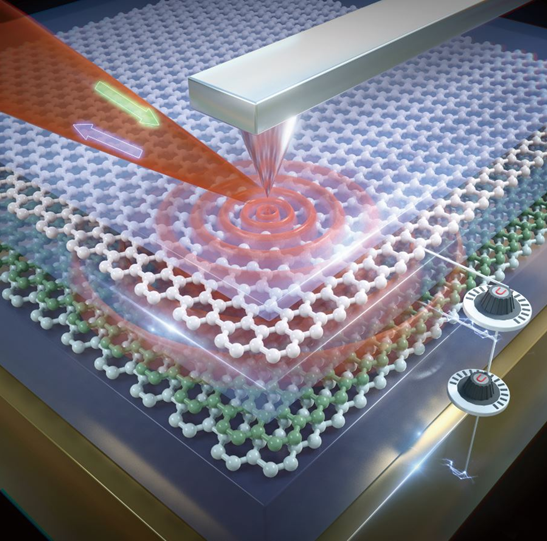Recently, the nano-optics group leaded by Prof. Jingju Xu, Wei Cai and associate Prof. Weiwei Luofrom school of physics&Teda institute of applied physicshas realized nanoscale optical characterization of dual-gate tunedbilayer graphene by employing near-field optical microscopy. This work,titled ‘Nanoinfrared Characterization of Bilayer Graphene Conductivity under Dual-Gate Tuning’, is published in Nano Letters in 1st June.
Two-dimensional (2D) heterostructures obtained by stacking of van der Waals layered materials exhibit rich phenomena, including bandgap opening in bilayer graphene (BLG), correlated insulator behavior and unconventional superconductivity in magic-angle graphene superlattices. Moreover, relying on the two degrees of freedom within dual-gate configuration, the carrier concentration and inter-layer electrostatic potential can be tuned independently, enabling novel behaviors, like the predicted 1D topological plasmon in BLG when the Fermi energy lies within the widely opened bandgap.
Optical probes, typically far-field spectroscopies provide indispensable information in revealing the physical mechanism behind. However, limited by the diffraction limit, the spatial resolution is on the order of the free space light wavelength, which exceeds several micrometers in the infrared range.The rapid development of scattering-type scanning near-field microscopy (s-SNOM) offers a nanoscale probe with a spatial resolution of 10-20 nm,widely employed for probing local optical properties, plasmon modes in metallic nanostructures, and 2D polaritons. The nano-optics group has carried out a series of in-depth studies in the field of nano-opticsby employing near-field optical technologyin recent years, including tailorable reflection of graphene plasmon waves enabled by manually induced electronic boundary (Advanced Materials, 29, 1701083 (2017)), high sensitive detection of 2D conducting electron system in oxide interface(Nature Communications, 10, 2774 (2019)).
In this research, systematic near-field studies on the optical properties of dual-gated BLG is demonstrated under a top gate of MLG. By taking advantage of the plasmon-coupling effect between MLG and BLG, the optical conductivities of BLG at varied combinations of dual-gate are characterized. In particular, the hybrid optical mode is detected through nano-infrared imaging, and the plasmon dispersions are matched quantitatively by calculations from tight-binding approximation. Especially, the electron-hole asymmetry in BLG is demonstrated in experiment. This research would enlighten the design and detection of hybrid plasmonic devices. Furthermore, the demonstrated nano-imaging of the tunable carrier concentrations and interlayer electrostatic potential provides a universal and sensitive nanoscale approach for investigating the rich phenomena including superlattice, topological boundary states in 2D heterostructures.

This work was supported by Guangdong Major Project of Basic and Applied Basic Research, the Program for the National Key R&D Program of China, the National Natural Science Foundation of China and the 111 Project.
Link of the article:https://pubs.acs.org/doi/full/10.1021/acs.nanolett.1c01167

